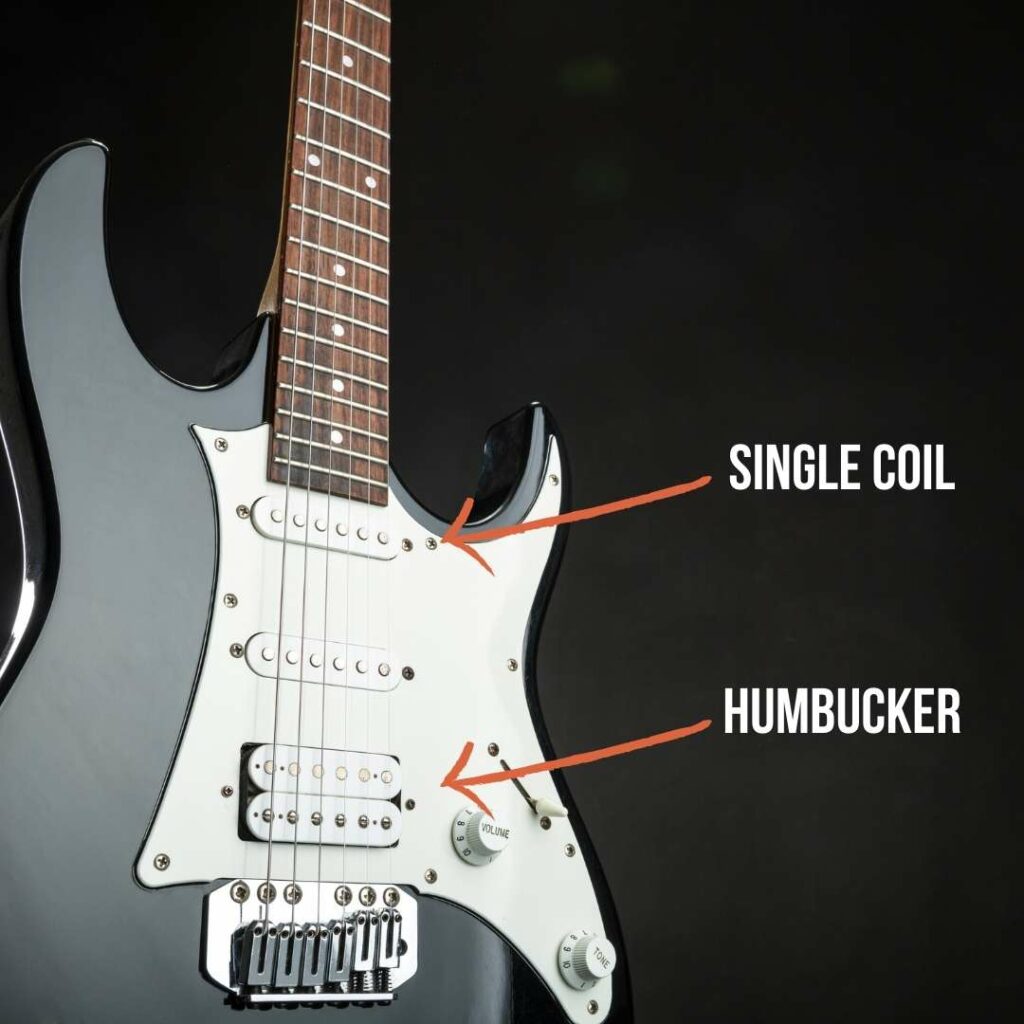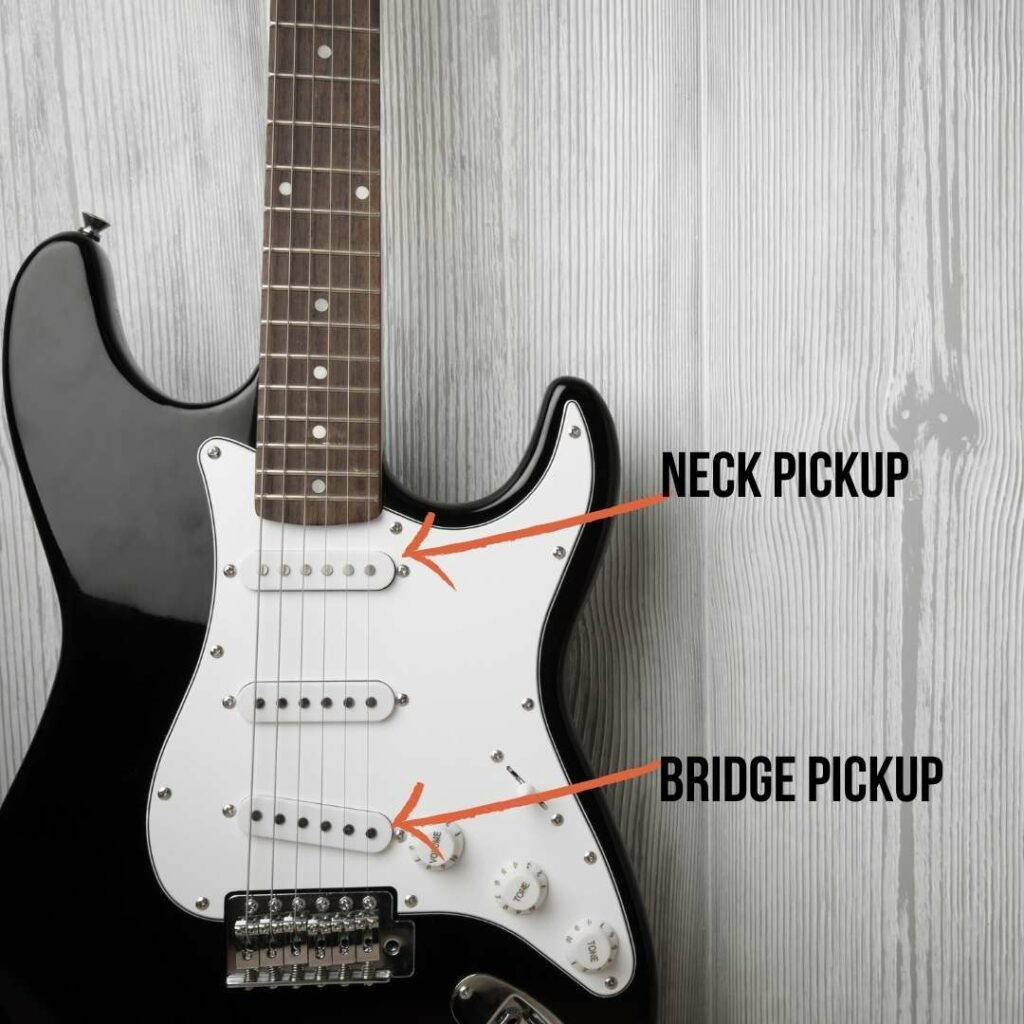One of the most critical factors in an electric guitar’s tone comes from the pickups. The overall sound quality and genre characteristics are heavily dependent on it.
There are different pickups, such as single-coil, humbucker, and P90s. While electric guitars have different pickup configurations, most have two pickups, one in the bridge and one in the neck position.
If you are new to electric guitars, you might not know the differences between bridge and neck pickups. Like how they sound or which one is best for rhythm, lead, rock n’ roll, or creamy jazz tones.
In this post, you will learn everything about the bridge vs. neck pickup debate – what they are, the tones they produce, when to use them, and which is better 😉
But first, let’s understand what exactly an electric guitar pickup is.
What Are Electric Guitar Pickups?
A guitar pickup is a device consisting of magnets wrapped in a copper wire and acts like a microphone. It converts string vibration into an analog signal that you hear coming from the guitar amplifier.
Different types of pickups are made with different methods. Depending on the pickup style, your guitar’s tone will have different EQ curves, output loudness, and clarity.
For example, single coil pickups output less volume and can be pretty noisy, especially when you plug it into a hi-gain amplifier. However, they tend to have a clearer, more articulate, and “jangly” sound that many players prefer for indie-rock, jazz, and punk rock guitar.
Most Fender Stratocasters and Telecasters use single-coil pickups if you’re looking to reference the sound.
On the other hand, humbucker pickups have a more powerful midrange that is louder, creamier and cancels out noise. These kinds of pickups are great for rock and metal guitarists.
Some guitars have one pickup (Gibson’s Les Paul Junior is a famous one), and some, like Stratocaster, have an additional middle pickup. Still, the most common combination is the neck and bridge pickup.
Now we’ll describe the difference between neck and bridge pickups.

Bridge Pickups
First, let’s start with the bridge pickup, which is usually the most favored by rock and metal guitarists. It’s an excellent choice for high-gain rhythm and lead guitar playing, where you need good note separation from your chords.
It’s installed next to the guitar’s saddle, or bridge, hence the name bridge pickup. This pickup is also referred to as the treble pickup.
98% of electric guitars have a bridge pickup, whether a single-coil or humbucker pickup. You can create various guitar tones with only the bridge pickup and tone knob; some players may find the tone they are after in the bridge pickup alone, depending on the guitar.
The Bridge Pickup Sound
Bridge pickups sound brighter and are more aggressive than neck pickups. The main reason is where the pickup is positioned.
The string has less room to vibrate by the saddle, and this results in a thinner and brighter guitar tone.
Also, because of this brighter guitar sound, bridge pickups can cut through a dense mix well and are great for recording and being heard over loud instruments, like drums, when playing live.
However, the bridge pickup can sometimes sound too thin and shrill on some guitars like the Stratocaster. But a Telecaster bridge pickup may give you that classic twang you’re looking for.
Use Cases
The bridge pickup position is useful in all styles of music. However, it excels in bringing out the best in your lead lines and playing chords that maintain clarity and don’t sound muddy.
No matter your music style, the bridge pickup works most of the time. For example, if you love playing metal and palm-muted riffs, then definitely use the bridge pickup to keep your tone powerful and tight.
Also, bridge positions are great for clean guitar tones with an added bite and focused presence.
Neck Pickups
The neck pickup is a favorite amongst many rock guitarists and has lots of mojo that can’t be ignored.
The neck pickup is also referred to as the rhythm pickup, and while great for rhythm guitars, it’s also highly practical for solos and creamy thick tones.
The Neck Pickup Sound
As the name suggests, neck pickups are placed where the body and neck of the guitar meet.
This part of the guitar is where the strings resonate the most, which creates more midrange and low-end tones. This makes the neck pickup position have a thicker and darker sound.
The neck pickup sound is great for blues leads, jazz tones, and singer/songwriter ballads. You can use the neck pickup for more “gainy” and gritty tones, but you have to be careful that the added midrange doesn’t get buried in the mix.
Use Cases for Bridge Pickups
Even though the neck pickup is called the rhythm pickup, many guitar players also love using it for lead tones. For example, playing blues or classic rock, you can create expressive and rich lead lines with the bridge pickup.
Also, if you want your rhythmic strumming guitar parts to be darker and rounder, which helps it sit back in the mix, the neck pickup is great for this.
But for heavy music, the neck pickup is not that great. The reason is that because it sounds a bit darker when you add distortion, the sound becomes muddy, and you lose note articulation within chords.
Many guitar players use neck pickup for rhythm if they aren’t playing with too much overdrive. When it comes to guitar solos, they switch to bridge pickup, which makes the guitar push forward in a mix.
But we all know that there are no rules in music. You can do whatever you want with your guitar if it sounds good to your ear. You can use neck pickup, bridge pickup, or even both together to create your sound.
The main difference is in characteristics and sound type. The bridge pickup is brighter, while neck pickups produce a more mellow, round, and heartfelt sound.

What about the Middle Pickup?
While we have spent this entire article discussing the neck vs. bridge pickup debate, we have glossed over the middle position pickup. You’ll find middle pickups on popular guitar models like the Stratocaster or PRS Blue Sky.
Middle pickups are often “split” with the neck and bridge positions using the pickup selectors to add extra dimension and a different tone to the guitar.
There’s a great article by Seymour Duncan on using middle pickups that you should check out here.
The Pickup Selector Switch
You don’t have to stick with the neck or bridge position. Most guitars will come with a pickup selector that is either 3-way or 5-way if you have a middle pickup.
These selector switches allow you to blend two pickups to create a more sonically diverse sound. Experimenting with the selector switch and the tone knobs will help you to unlock the possibilities of your instrument and help you dial in the tone you are looking for.
Other Frequently Asked Questions
Should bridge pickups be higher than neck pickups?
No, there is no “correct” height for the pickups. Different guitarists will have other preferences for pickup height.
Some guitarists like to lower the neck pickup to even out the tone and roll off the bass. But other factors play into this as well.
If you’re unsure why you would raise or lower your electric guitar pickups, it’s best to leave them as is or have a professional advise you on what to do.
Can you install a pickup in an acoustic guitar?
Yes, pickups for acoustic guitars can be installed, making it an acoustic-electric guitar. Most acoustic guitars come with built-in pickups, but sometimes you’ll need to install one.
The Bottom Line
Now that you know there is no clear winner in the neck vs. bridge pickup debate, you’ll have to decide what kind and how many pickups you want to equip your guitar.
While choosing the perfect pickup and guitar is a matter of personal preference, one of my favorites has always been the p90 style pickup.
A p90 has a great blend of a single coil and humbucker pickup and gives guitars tons of attitude that is great for various styles.
I’ve created a resource around the best p90-equipped guitar on the market today that you should go check out now! You’ll have a great appreciation now that you’ve read this article.
Thanks for reading, and happy playing!

